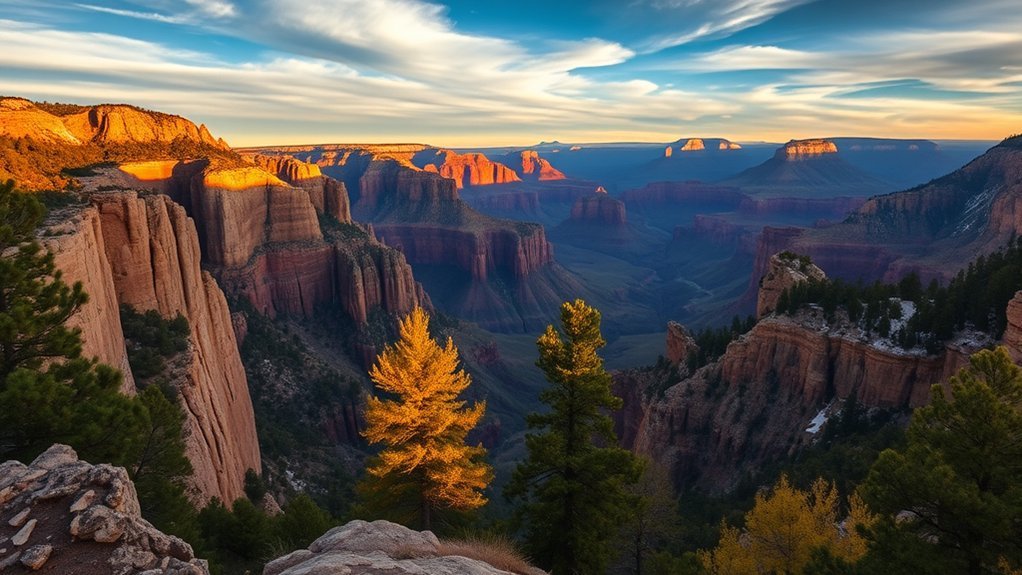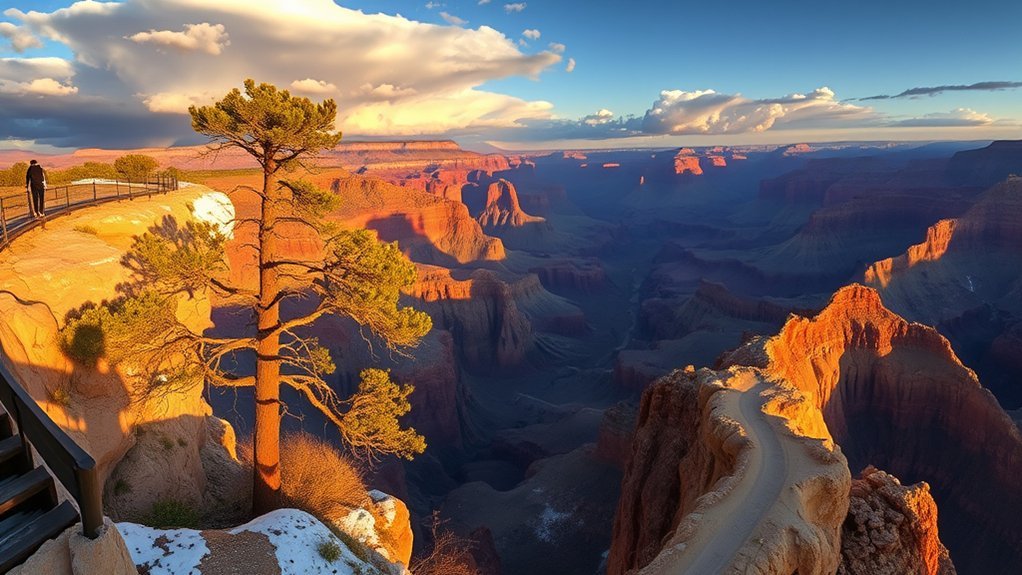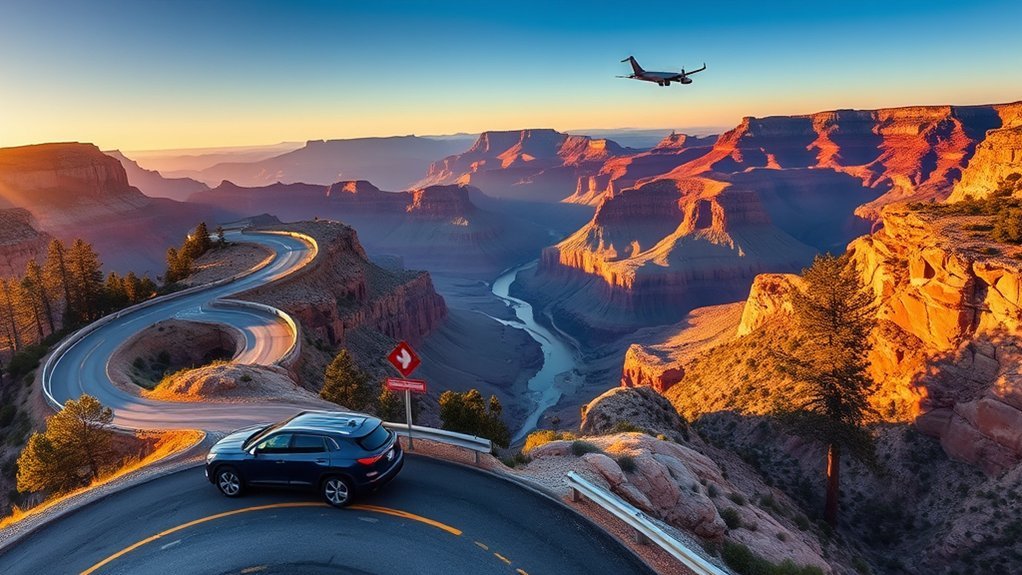If you’re planning a visit to the Grand Canyon’s North Rim, this guide helps you choose the best season, routes, and hikes while avoiding common mistakes; you’ll get practical tips on lodging, permits, road conditions, and safety at this quieter, higher‑elevation rim. Learn where to catch sunrise and sunset, which trails suit your fitness, and what services are limited—so you can make confident decisions before you go.
North Rim Vs South Rim: Which One Is Right for You?

While both rims give you jaw‑dropping canyon views, they serve very different experiences: the South Rim is developed, busy, and open year‑round with full services and classic overlooks, whereas the North Rim sits about 1,300 feet higher, feels cooler and forested, receives roughly 10% of visitors, and operates seasonally—best for solitude, cooler summer hikes, and wooded viewpoints that look more directly toward the river. You’ll pick the South Rim when you want easy logistics, shuttle buses, abundant lodging, and iconic overlooks like Mather Point and Desert View. Choose the North Rim if you value quieter trails, alpine forest shade, and overlooks such as Bright Angel Point and Cape Royal that aim your view more toward the Colorado River. Grand Canyon Lodge anchors the North Rim experience with seasonal lodging and the campground, so plan around its open dates. In short, go South Rim for services and access; go North Rim for solitude, cooler temps, and a forested, intimate canyon encounter.
When to Visit: Seasons, Weather, and Crowds

Plan your trip for mid‑May through late October when the lodge, campground, and most services are open, but know that visiting near opening or closing can mean snow or limited services. At roughly 8,000–8,800 feet you’ll see temperatures about 5–10°F cooler than the South Rim, with summer highs in the 70s–80s°F and chilly nights, so pack layers and check conditions. Expect far fewer people than the South Rim—the North Rim gets about 10% of park visitors—so late May–early July and September–October offer the best balance of reliable weather and lighter crowds.
Best Months to Go
Because the North Rim sits about 1,300 feet higher than the South Rim and closes seasonally, the best months to visit are those that balance cooler, stable weather with open roads and services—typically late May through early July and again September through October. You’ll find milder daytime temperatures, far fewer visitors than the South Rim, and most facilities and the Kaibab Plateau road operating. Avoid mid‑May and late October if you need guaranteed access; lingering snow or early storms can still affect openings. July–August brings warmer days and higher weekend crowds around the lodge and Bright Angel Point. If you plan longer hikes, go late spring through early fall, start early, and check current opening dates, trail conditions, and water availability before you travel.
Weather and Elevation
With the seasonal openings and crowds in mind, you’ll also want to account for how elevation shapes weather on the North Rim. Sitting about 1,300 feet higher than the South Rim—around 8,000 feet on average—the North Rim brings predictably cooler temperatures: summer highs run 5–10°F lower and nights often dip into the 40s°F. Expect large diurnal swings, rapid changes at high elevation, summer monsoon storms, and possible residual snow in spring. Services and access are typically mid‑May through late October; travel near opening or closing risks snow‑impacted conditions. Best windows for reliable access and pleasant weather are late May–early July and September–October. Pack layers, a warm night layer, and be ready for sudden storms.
Crowd Levels and Timing
Typically, the North Rim feels much quieter than the South Rim—you’ll see roughly 10% of the park’s visitors—so timing your trip can make a big difference in solitude and access. The North Rim is open mid‑May through late October (dates shift with snow); roads are usually closed in winter, so confirm opening dates before you travel. Peak visitation runs June–September; for the most solitude visit right after opening in May or in September–October when crowds thin but services remain available. Summer mornings and evenings can be chilly due to higher elevation, so pack layers. For sunrise or sunset photography with fewer people, aim for Cape Royal, Point Imperial, or Bright Angel Point early or late in the season.
Getting There: Driving Routes and Flying Options

You’ll reach the North Rim mainly via AZ‑67 from Jacob Lake—a 44‑mile paved climb through Kaibab National Forest to the park entrance, then about 15 miles to Grand Canyon Lodge. If you’re coming from the South Rim expect roughly 220 miles (about 4.5 hours) following AZ‑64 → US‑89 → US‑89A → AZ‑67; Las Vegas (≈270–275 miles) and Page, AZ (≈122 miles) are the closest commercial airports by road. Check seasonal road closures (North Rim typically open mid‑May to mid‑October), bring a National Park Pass, and plan to refuel at Jacob Lake.
Driving Routes and Distances
Although remote, the North Rim is reachable by a few well‑defined routes: AZ‑67 climbs 44 miles from Jacob Lake up the Kaibab Plateau to the park entrance, then about 15 more miles to Grand Canyon Lodge and the rim viewpoints; expect roughly a 220‑mile (~4.5‑hour) drive from the South Rim (AZ‑64 → US‑89 → US‑89A → AZ‑67) and about 270–275 miles (~4.5 hours) from Las Vegas, while Page is closer by road at roughly 122 miles (~2.5 hours) if you’re combining the trip with Lake Powell or Antelope Canyon. Plan travel between mid‑May and late October when AZ Highway 67 and in‑park services are open; winter closures (typically Dec 1–May 15) block vehicle access. Remote viewpoints require long dirt roads, high‑clearance or 4WD, permits and self‑sufficiency.
Airports and Flight Logistics
When planning air travel to the North Rim, fly into Las Vegas Harry Reid International for the most direct route—about a 270–275 mile, roughly 4.5‑hour drive. From there you’ll drive north and east toward the Kaibab Plateau; turn south from US‑89A at Jacob Lake onto AZ‑67, then continue about 30 miles to the park entrance and another ~15 miles to the rim and Grand Canyon Lodge. Phoenix is an alternate hub but adds significant drive time (about 5–6 hours). Consider regional connections via Page (122 miles) or Kanab (about 80 miles) for shuttles or combined trips to Zion, Bryce, Antelope Canyon, and Horseshoe Bend. Note: North Rim services and road access on AZ‑67 operate mid‑May through late October; winter closures limit practical air‑arrival transfers.
Park Access, Passes, and Permits
Most visitors need a standard Grand Canyon/National Park entrance pass (for example, private vehicles have been charged $35 in recent years) and should display it at the North Rim entrance station. At the Grand Canyon North Rim you don’t usually need an advance reservation to drive in during the open season, but note the road and facilities typically open mid‑May through mid‑October, weather permitting. Pick up the North Rim pocket map and services guide at the entrance or visitor center or download it for current fees, road closures, and permit rules.
Some remote areas (like Toroweap/Tuweep) require separate day‑use permits in addition to the park entrance; fees have been nominal. If you plan to camp below the rim, stay overnight at Cottonwood or Phantom Ranch, or undertake extended hikes, obtain backcountry permits from the park’s Backcountry Office well in advance. Confirm requirements before you go to avoid delays or denied access.
Where to Stay: In-Park Lodging and Nearby Options
When planning your North Rim visit, you’ll want to weigh in-park options like Grand Canyon Lodge and the seasonal North Rim Campground against nearby lodges and inns. Grand Canyon Lodge (May–Oct) and about 87 campground sites offer the closest access but book far in advance; off‑park choices like Kaibab Lodge, Jacob Lake Inn, and Kanab provide more availability and services. I’ll outline in-park lodging types, campground facilities and fees, and practical nearby accommodations so you can pick what fits your trip.
In‑Park Lodging Options
Although the North Rim’s options are limited compared with the South Rim, you can still stay right inside the park or at a handful of nearby lodges and campgrounds that keep you close to the rim and trails. Grand Canyon Lodge (open roughly mid‑May–mid‑October) offers rustic motel rooms and cabins—some with rim views—plus a dining room and veranda; book more than a year ahead for peak dates. The North Rim Campground has about 87 non‑hookup sites, opens seasonally, and takes reservations via recreation.gov. If in‑park lodging is full, Kaibab Lodge (5–6 miles from the entrance on AZ‑67) provides log cabins and an on‑site restaurant with easier availability. Expect limited cell service and minimal amenities; reserve early.
Campground & Facilities
Typically, you’ll find limited but well‑managed campground and lodging options on the North Rim, so it’s smart to book early and plan for seasonal closures. You can stay at Grand Canyon Lodge (mid‑May to mid‑October) for historic rimside rooms and cabins—reserve more than a year ahead for canyon views. The North Rim Campground offers 87 non‑hookup sites, coin showers and a general store for about $18/night during the same season; expect no hookups and limited services. If in‑park lodging fills, Kaibab Lodge and Jacob Lake Inn provide nearby alternatives. Planning multi‑day treks? Obtain a permit for backcountry camping (including North Kaibab Trail overnight use). Know seasonal dates and book permits and sites long before arrival.
Nearby Town Accommodations
If you can’t secure a room at Grand Canyon Lodge, you’ve still got solid options nearby: Kaibab Lodge sits just outside the North Rim entrance with log cabins and an on-site restaurant, Jacob Lake Inn is about 45 minutes north on US‑89A and offers rooms, cabins, and the nearest full‑service gas and stores, and Kanab, Utah (roughly 80 miles away) provides the widest range of hotels, B&Bs, and vacation rentals for multi‑park trips. The North Rim Lodge dominates in‑park stays (mid‑May–mid‑Oct) with rim‑view cabins and dining; book months ahead. North Rim Campground holds 87 non‑hookup sites; reserve via recreation.gov. If the lodge fills, Kaibab Lodge and Jacob Lake Inn are practical alternatives; Kanab serves as a larger hub.
- In‑park: North Rim Lodge (limited season)
- North Rim Campground
- Kaibab Lodge (5–6 miles out)
- Jacob Lake Inn (30 miles)
- Kanab, UT (wide selection)
Best Scenic Drives and Overlooks (Cape Royal, Point Imperial, Toroweap)
When you drive the North Rim’s scenic spurs, you’ll find three standouts: Cape Royal for sweeping sunset panoramas from 7,865 ft (with stops like Angels Window), Point Imperial for the highest and northernmost vantage at 8,803 ft with views of the Painted Desert and Precambrian exposures, and remote Toroweap (Tuweep) for a vertigo-inducing ~3,000‑ft drop to the Colorado River and Lava Falls—each requires different roads, vehicles, and planning so know conditions, bring layers and a flashlight for pre-dawn or dusk runs, and expect rough dirt access plus a $2 day-use permit for Toroweap. You can reach Cape Royal via the paved 23-mile Walhalla Plateau road; it’s ideal for sunset shots and works for most passenger cars. Point Imperial sits on an 11-mile spur and delivers unique northern panoramas. Toroweap demands long, rough dirt travel, high-clearance or 4WD, self-sufficiency and caution for slow speeds and flats. Plan timing, check road reports, carry water, a spare tire and emergency gear, and respect limits at cliff-edge overlooks.
Top Hikes and Backcountry Routes (Day Hikes to Multi-Day Trips)
After you’ve taken in the rim overlooks, many visitors head onto trails to experience the canyon up close—choices range from short, paved walks to strenuous descents that require planning and permits. You can choose easy rim walks or tackle longer routes depending on fitness and time. Bright Angel Point offers a half-mile paved view for minimal effort. The Cape Final Trail gives a mostly level ~4.2-mile round trip on Walhalla Plateau with intimate views of Vishnu and Jupiter temples. For longer day challenges, the North Kaibab Trail includes options like a 9.4-mile round trip to Roaring Springs (≈3,050 ft elevation change, 7–8 hours) or shorter turnarounds at Supai Tunnel. The Widforss Trail delivers 9.6–10 miles through ponderosa forest to cliff-edge overlooks (about 5–6 hours). If you’re experienced, the full North Kaibab rim-to-river 28-mile descent requires backcountry permits and careful planning.
After rim overlooks, choose anything from short paved walks to strenuous, permit-required descents—pick routes by fitness and time.
- Bright Angel Point (0.5 mi)
- Cape Final Trail (~4.2 mi)
- North Kaibab day options
- Widforss Trail (9.6–10 mi)
- North Kaibab multi-day (permit required)
Photography Tips: Sunrise, Sunset, and Low-Crowd Spots
Get out early or stake a spot well before sunset to make the most of the North Rim’s light and lower crowds—Bright Angel Point is the easiest pre-dawn option (0.5‑mile paved) but for sweeping panoramas aim for Cape Royal or Point Imperial and arrive 30–60 minutes ahead to set up. Bring a headlamp and jacket; mornings run 5–10°F cooler than the South Rim. Use a wide-angle for grand vistas and a 200–400mm telephoto to isolate temples and river details. Bracket exposures at sunrise and sunset to handle extreme dynamic range between rim shadows and sunlit cliffs. The Grand Canyon Lodge veranda and Bright Angel Point offer convenient sunset viewpoints with minimal hiking—claim spots early. For dramatic, low‑crowd compositions consider Toroweap/Tuweep only if you’re self‑sufficient, have spare tires, and secure required permits; remote dirt roads demand planning. Pack a sturdy tripod, extra batteries, and neutral density or polarizing filters to control light and enhance color at golden hour.
Safety, Road Conditions, and Wilderness Preparation
Because the North Rim sits near 8,000 feet and has limited services, you should plan conservatively: check AZ‑67 road status (it often closes in winter, roughly Dec 1–May 15), expect cooler temps and stronger UV, and carry extra water, layers, and sun protection to avoid altitude-related problems. Road conditions change quickly; confirm closures and drive prepared with a full tank, spare tire, and a vehicle emergency kit. Cell service is sparse, so leave an itinerary and bring maps and a headlamp. Trails like the North Kaibab Trail are strenuous—know turnaround times, carry ample water, and be ready for extreme temperature shifts. Many remote areas and overnight trips require backcountry permits; apply in advance and follow route-specific guidance. Weather, road conditions, and vehicle capability determine access to viewpoints like Toroweap or Point Sublime, so only attempt routes within your skill and equipment limits.
- Check AZ‑67 and local road conditions before departure
- Carry extra water, layers, and sun protection
- Pack emergency and vehicle repair gear
- Obtain required backcountry permits
- Leave a detailed itinerary with someone trustworthy
Dining, Ranger Programs, Mule Rides, and Visitor Services
While the North Rim’s services are seasonal, you’ll find enough on-site amenities during mid‑May through mid‑October—most conspicuously the historic Grand Canyon Lodge dining room with panoramic rim views—so plan reservations early and check opening dates before you go. The dining room serves regional dishes (Lees Ferry trout, Hualapai buffalo) and gives priority to lodge guests; book ahead.
Ranger programs depart from the Visitor Center next to the Lodge and include morning nature walks and evening geology, wildlife, and cultural-history talks; check the daily schedule at the Visitor Center for times. Mule rides run through Canyon Rides/Grand Canyon Outfitters: choose a one-hour rim ride, three-hour Uncle Jim’s Point, or three-hour Supai Tunnel descent on the North Kaibab Trail; age and weight limits apply and reservations are required.
Visitor services are basic: maps, exhibits, bookstore, limited groceries, coin showers/laundry, and very limited cell service. Confirm seasonal openings and secure lodging, mule, and dining reservations well in advance.
Frequently Asked Questions
How Much Time Do You Need to See the Grand Canyon North Rim?
For a quick taste, plan 2–3 hours; a scenic half‑day takes 4–5 hours; a full day needs 6–10 hours for hikes and sunset; reserve 7–10+ hours for strenuous canyon hikes or mule trips, or 2–3 days.
Is It Worth Going to the North Rim of the Grand Canyon?
Yes — it’s worth it if you want solitude, cooler forests, and dramatic, different viewpoints; you’ll experience fewer crowds, excellent sunrise/sunset photo ops, and unique geology, though you’ll need to commit to seasonal access and a long drive.
What to Do at the North Rim of the Grand Canyon?
Hike Bright Angel Point, drive Cape Royal Road, climb North Kaibab, savor sunset from Grand Canyon Lodge, scout secluded spots like Point Imperial, and pursue remote viewpoints—plan permits, reservations, and sturdy gear; you’ll prioritize safety and spectacular scenery.
Why Is Grand Canyon North Rim Closed?
It’s closed mainly because heavy winter snow and high elevation make roads, utilities, lodging, and staffing unsafe or impractical; seasonal access and supply limits force a typical Dec–mid‑May closure, so check current NPS updates.
Conclusion
Whether you seek solitude or sweeping panoramas, the North Rim rewards planning and a flexible spirit. Visit mid‑May to mid‑October, book lodging and permits early, and pack layers, water, and a spare tire. Drive AZ‑67 with caution, check trail and road conditions, and respect wilderness rules. Follow Leave No Trace, keep an eye on weather, and you’ll experience quieter viewpoints and memorable hikes—it’s the whole package, but don’t count your chickens before they hatch.

